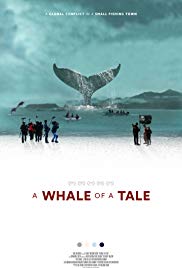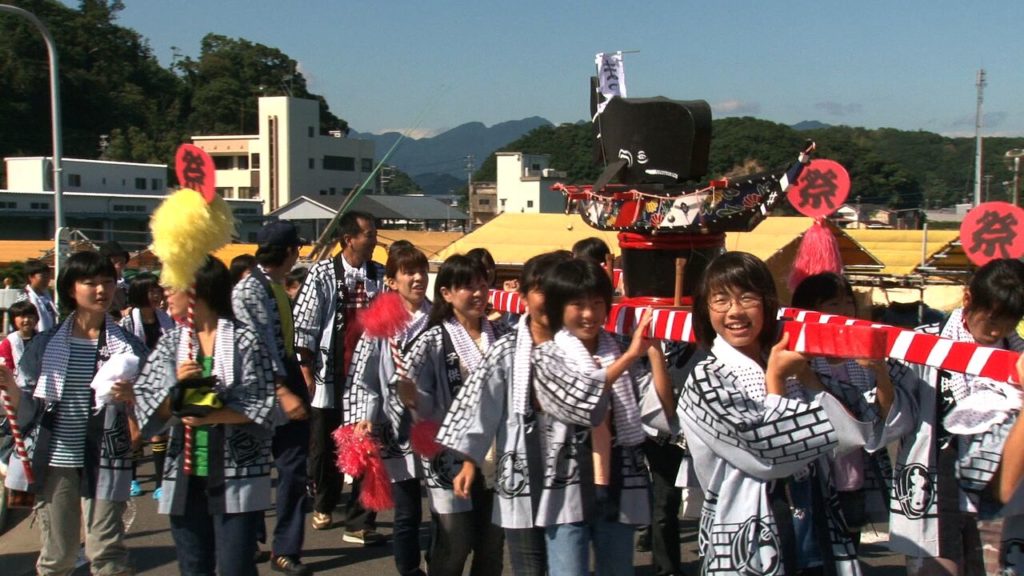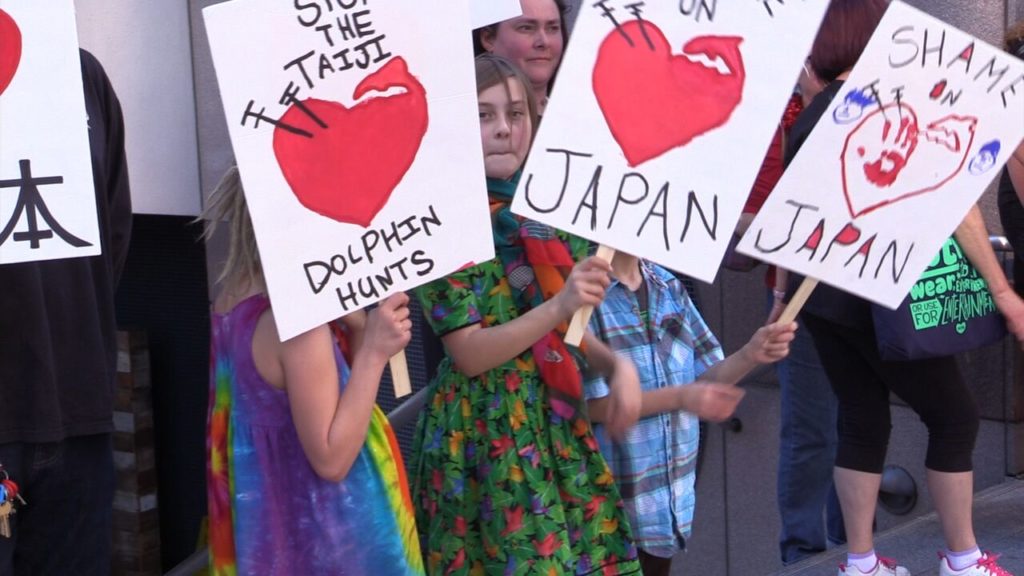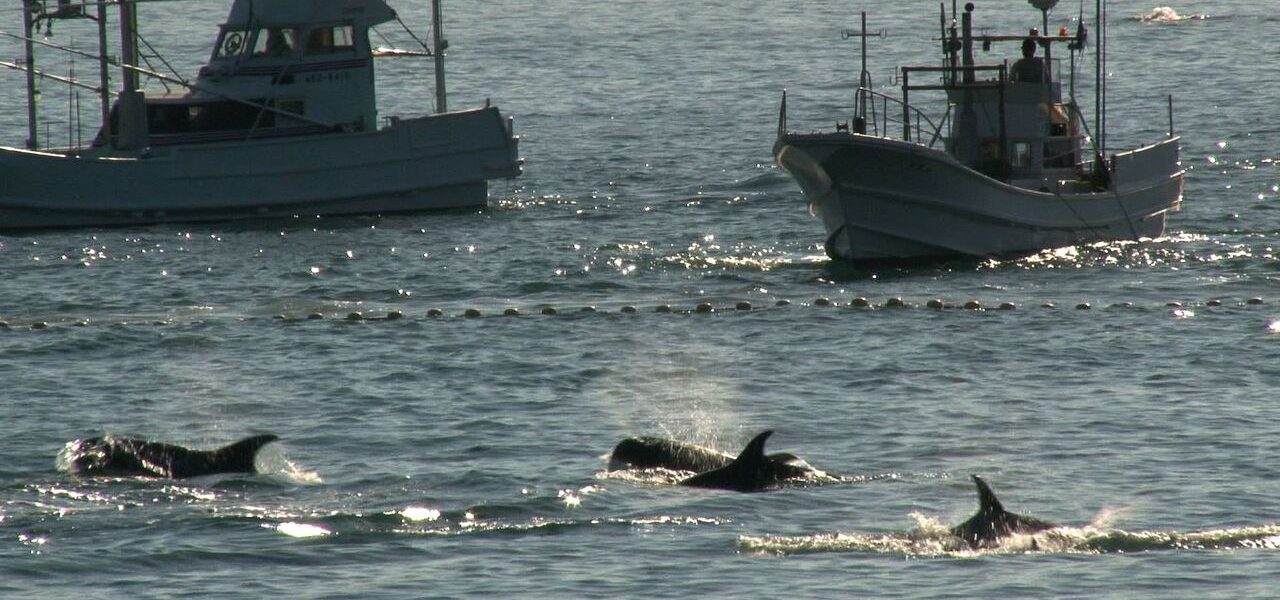An Even-Handed Examination of an Incendiary Issue
DIRECTED BY MEGUMI SASAKI / 2018
 The Cove is a documentary from 2009 detailing the efforts of activists to expose the whaling practices of a small town in southern Japan. For 400 years, fishermen in Taiji have herded pods of small whales and dolphins into a secluded cove and then kill them for their meat. To the Western world, the idea was horrific and The Cove sparked international outrage against the practice wherever it was seen. When The Cove won the Academy Award for Best Documentary Feature, its reach was increased and before long, activists from all over the world were pouring into Taiki (whose population is just around 3000 people- this is not a large town) to protest the tradition of killing and eating whales and dolphins.
The Cove is a documentary from 2009 detailing the efforts of activists to expose the whaling practices of a small town in southern Japan. For 400 years, fishermen in Taiji have herded pods of small whales and dolphins into a secluded cove and then kill them for their meat. To the Western world, the idea was horrific and The Cove sparked international outrage against the practice wherever it was seen. When The Cove won the Academy Award for Best Documentary Feature, its reach was increased and before long, activists from all over the world were pouring into Taiki (whose population is just around 3000 people- this is not a large town) to protest the tradition of killing and eating whales and dolphins.
A Whale of a Tale (okay, right off the bat, I have to say that’s a dumb title for this otherwise exemplary documentary) is a sort-of sequel to The Cove. Directed by documentarian Megumi Sasaki, A Whale of a Tail fills in the blanks left by The Cove’s story. The Cove was laser-focused on the activists’ attempts to free the whales that had been captured by the fishermen prior to the slaughter. Sasaki’s film talks to the activists who still remain in Taiji, but it also brings the fishermen, the local politicians and an American journalist/longtime Japan resident into the conversation as well. It broadens the picture first painted by The Cove, allowing everyone on both sides of the issue have a say.

Relative to their body size, dolphins have the largest brains on the planet. They are phenomenal problem-solvers, they can plan for future events, their sonar is so precise they can tell what an object is made off from 100 yards away, their paralimbic system- used to process emotion- is highly developed, and the sounds they make- the whistles and clicks- may actually constitute a language. Killing and eating a dolphin must fall somewhere just below cannibalism.
This is at least as far as Western culture is concerned. In Japan, dolphins and whales were considered as just another type of fish. They are a resource meant to be used and exploited, just not to the point of exhaustion. And for coastal towns like Taiji who were faced with crippling food shortages following the wake of World War II, dolphin meat meant a literal difference between life and death.
Now the war is long since over, and Japan is a prosperous country that should no longer need to rely on dolphin meat for food. But fishermen in Taiji have been hunting whales and dolphins for 400 years. That’s not something that just ends overnight. Still, just because something has been done for a long time, that doesn’t make it a good thing to do. The United States has its own share of issues with progress butting heads against ‘tradition.’ Just look to all the people defending the Confederate flag and everything it represents. There comes a time to acknowledge that a tradition and a culture is at heart harmful and it must be put to rest. Remembered, yes, but nevermore celebrated.

Still, foreigners coming to Taiji and screaming about how terrible the fishermen are aren’t going to change things. In one sequence, a fisherman is shown printouts of angry tweets and Facebook comments. “I hope you die,” one says. Another reads “We should hire a hitman,” and a third threatens rape. Protestors scream at the departing boats that the fishermen’s mothers should be ashamed for giving them birth. How can constructive progress occur in the face of such hate and anger?
During a joint press conference, Scott, a Sea Shepherd activist, is asked if there was a middle ground where the two sides could agree upon. Of course, he says. When asked what that middle ground would look like, Scott replies that the fishermen will have to stop hunting whales for food and live-capture. And that’s not ‘the middle’ but pretty much everything Sea Shepherd wants.
Organizations like Sea Shepherd want to stop the whale hunts, but because they are comprised mostly of outsiders, non-Japanese people, it becomes easy for the Japanese to dismiss their efforts as being, not anti-whaling, but anti-Japanese. The whalers and their supporters can frame arguments against whaling as racist. This has made it hard for Japanese citizens to speak out against the practice without suffering terrible backlash. Sasaki interviews one such woman, who has been campaigning against whaling since the mid-1990s. She has received countless death threats since she began her work, and has even kept copies of the most egregious ones for her own amusement.

Activists tried coming at the problem through a public health angle. There was concern over the large amount of mercury and other heavy metals found in dolphin meat- especially as whale meat is served at least once a month at the local elementary school. The town agrees on testing, and the mayor admits that if the test do not “turn out the way we expect,” they might have to consider big changes. It is found that although the average citizen of Takiji has four times the level of mercury in their blood than an average Japanese citizen, it still does not present a significant health risk, except for unborn fetuses. So if you’re pregnant, maybe cut back on the dolphin.
A Whale of a Tale (that’s still a really stupid title, I’m sorry) is an even-handed look- not of the practice that gave Taiji its international notoriety in the first place, I feel Sasaki’s film comes down on the side of wishing to stop the hunts. But the movie gives a fair shake to the town and its people and how they have to live with the spotlight that’s been suddenly turned onto them. 400 years of whaling and suddenly within the past 10 they’re told the hunt is a terrible evil and they should all be ashamed. It’s clear that as international pressure grows, the town has to change. Sasaki’s film is a good step in furthering the dialogue that has to occur within Taiji itself for meaningful progress to happen.


